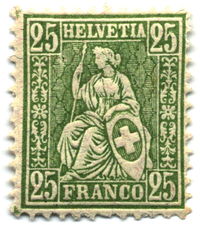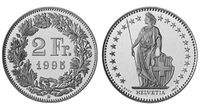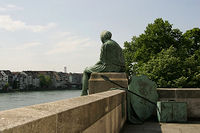Helvetia


Helvetia is the female national personification of Switzerland, officially Confœderatio Helvetica, the "Helvetic Confederation".
The allegory is typically pictured in a flowing gown, with a spear and a shield emblazoned with the Swiss flag, and commonly with braided hair, commonly with a wreath as a symbol of confederation. The name is a derivation of the ethnonym Helvetii, the name of the Gaulish tribe inhabiting the Swiss Plateau prior to the Roman conquest.
The Helvetia figure first appears in 1672, in a play by Johann Caspar Weissenbach, as a symbol of unity of the Old Swiss Confederacy in the face of the denominational disputes initiated by the Swiss Reformation. Identification of the Swiss as "Helvetians" (Hélvetiens) becomes common in the 18th century, particularly in the French language, as in François-Joseph-Nicolas d'Alt de Tieffenthal's very patriotic Histoire des Hélvetiens (1749–53) followed by Alexander Ludwig von Wattenwyl's Histoire de la Confédération hélvetique (1754). Helvetia appears in patriotic and political artwork in the context of the construction of a national history and identity in the early 19th century, after the disintegration of the Napoleonic Helvetic Republic, and she appears on official federal coins and stamps from the foundation of Switzerland as a federal state in 1848.
The Swiss Confederation continues to use the name in its Latin form when it is inappropriate or inconvenient to use any or all of its four official languages. Thus, the name appears on postage stamps, coins and other uses; the full name, Confœderatio Helvetica, is abbreviated for uses such as the ISO 3166-1 alpha-2 and vehicle registration code CH, and the ccTLD, .ch.
Notably, translations of the term Helvetia still serve as the name for Switzerland in languages such as Irish, in which the country is known as An Elvéis, Greek, in which it is known as Ελβετία (Elvetia) and Romanian, Elveţia. In Italian Elvezia is seen as archaic, but the demonym noun/adjective elvetico is used commonly as synonym of svizzero.
See also
- Augusta Raurica
- Historiography of Switzerland
- Aventicum
- National personification
- Vreneli
References
External links
|
|||||
| This Switzerland-related article is a stub. You can help Wikipedia by expanding it. |
| This sculpture article is a stub. You can help Wikipedia by expanding it. |
| This culture-related article is a stub. You can help Wikipedia by expanding it. |
